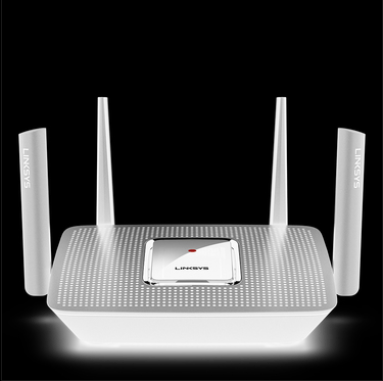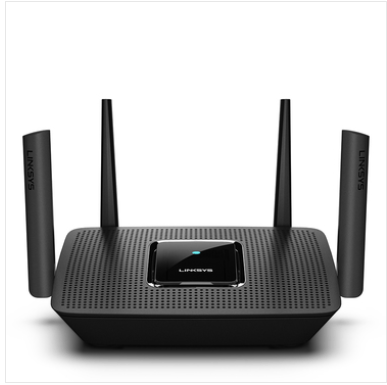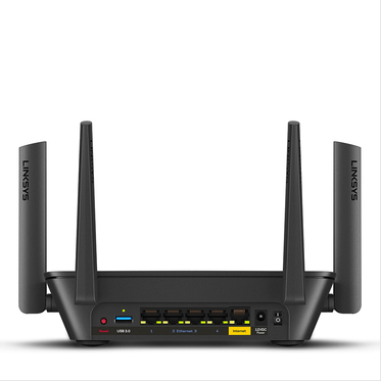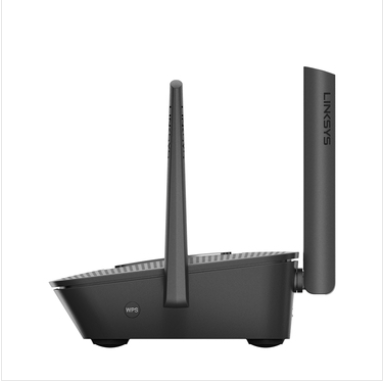
Pros
- Easily manageable
- The installation process is easy
- Throughout is solid
- Offers Velop mesh technology
- Supports MU-MIMO technology
Cons
- Parental controls are limited
- Lack of built-in protection against malware
- Disabled USB port
Summary
The new Linksys MR8300 is the latest in the long line of tri-band WiFi routers from Linksys.
And when you pair it with the new Velop node the new Linksys MR8300 is able to form a complete mesh network as well.
Our research shows that it has a solid performance in almost all areas where you would want a good router to perform.
With that said, it is also true that it lacks some of the critical features that good routers offer such as decent parental control components and malware protection.
Table of Contents
Linksys Max-stream AC2200 full review
From the looks of it, you would not consider the Linksys MR8300 router (which costs around $179.99) as anything but your run-of-the-mill router.
Indeed, in many ways, the new Linksys MR8300 WiFi router is a typical WiFi router.
The Linksys MR8300 comes with multiple external antennas and offers users multiple LAN ports.
Moreover, it has a pretty traditional router form factor as well.
On the other hand, it also offers users the new Velop mesh technology.
This is a technology that enables users to build, from the ground up, complete home WiFi systems.
And all they need to use for that purpose is Linksys’ Velop nodes.
Now, there is nothing stopping you from using the new Linksys MR83300 as a single individual unit, you do have the option of hooking the router up to any given Velop node in order to access all the benefits that a mesh network brings to the table.
We’re talking about benefits such as,
- Seamless roaming
- Easy management
- Onet network password and SSDI
As mentioned at the top as well, the Linksys MR8300 is a solid and strong performer.
But against the likes of TP-Link Deco (AC 2200 Smart Mesh WiFi system) M9 and others, it simply does not have the ability to match either the performance or the features.
Router or a mesh system?
Depends on what you want.
As alluded to before, the MR8300 looks pretty similar to the earlier EA8300 model which came out last year.
The MR8300 measures 2.1 inches by 8.4 inches by 6.3 inches (height x width x depth).
Moreover, it has a textured black finish.
As for the antennas, it has four of them and all are non-removable but adjustable.
The top of this router has a glossy black panel.
It makes use of a uni-color LED in order to let the user know what is going on at a given moment.
If the light is blinking and is blue then that means that the Linksys router is going through the process of starting up.
If the single LED is giving off a solid purple vibe then that means it has made preparation for the setup process.
If the light is blinking and is purple in color then that means the installation setup is currently in progress.
The LED light turns solid blue when it has successfully managed to connect to the internet and is also ready to get to work.
This same LED light turns to complete red if you have lost any and all internet access.
If you look at the back of the router you will see four gigabit LAN ports.
There is also a power port and a WAN port along with the standard power and reset buttons.
One oddity that we have come to know just recently is the USB 3.0 port which seems like it is reserved for something coming in the future.
In other words, there is no way for the user to make use of the USB 3.0 port, in order to connect the router to some external peripherals such as printers and hard drives.
With that said, we are sure that Linksys has plans to completely rectify this problem more or less in the near future firmware patches or updates.
Speed and specs
As far as the speed number is concerned, since the new MR8300 is a max-stream AC2200 tri-band WiFi router, it is able to reach speeds of close to 867 Mbps on its two 5 GHz bands (that’s 867 Mbps for each one ) and 400 Mbps on its 2.4 GHz band.
As far as the processor is concerned, the MR8300 comes with a quad-core CPU.
That is enough for most online consumers.
Apart from that, the router is equipped with 256 MB of flash memory along with 512 MB of RAM.
Moreover, it also has support for MU-MIMO (Multi User-Multi Input Multi Output) simultaneous data streaming features.
Not only that, there is also a Smart Connect feature which enables automatic band-steering.
And if you always wanted to have a faster WiFi connection but did not know how to get it, then the Linksys MR8300 also supports direct-to-signal signal beamforming which does exactly that.
With that said, you should know that even if you enable the Smart Connect feature you will still have the opportunity to separate the available bands if you would like that.
The Linksys MR8300 makes use of the company’s proprietary Velop mesh technology.
This allows users to build a working WiFi system just by using a given Velop node.
However, in order to do so, the user has to make sure that the Linksys MR8300 is acting as the primary (main) node which has a direct connection to the user’s modem.
Now, when a user pairs it with the Linksys Velop AC2200 tri-band node, the router is able to provide users up to a total of 4500 square feet of pure WiFi coverage.
This coverage matches exactly with the Deco M9 Plus.
Mobile apps
On that note, we should also mention that you can, if you want to, manage your Linksys MR8300 router by making use of the official Linksys mobile application which is available both on the Android and iOS platforms.
If you do not want to do that then you can also use the web console that Linksys Smart WiFi has made available to Linksys users.
Regardless of your choice, both options offer pretty much the same set of settings.
However, the main difference between usage is that if the user wants to separate the available WiFi bands, he/she has to do so via the web console.
As far as the official mobile app is concerned, it is pretty similar to the one that users have to use in order to manage the Plug-in and Velop Tri-band systems.
From a design perspective, our research shows that the app is easy to use.
When you open the app, it shows the user a Dashboard screen.
The Dashboard, as expected, displays the name of the current WiFi network along with the total number of connected internet-enabled devices and Internet status.
If the user clicks on the WiFi tab, the app takes him/her to a new screen where he/she is able to change the password and name of the given network.
On the same screen, there are also options for changing the current security settings and managing the WiFi mode.
Additionally, there is also a channel finder feature here that the user can utilize to scan for various WiFi channels and then pick the one that has the least amount of user traffic.
Now, below that, there are different tabs for users who want to enable parental controls and/or guest networking.
This tab also allows users to assign device prioritization.
Needless to say, the parental controls available via this router allow the user to do things such as,
- Instantly stop/pause a device’s internet access.
- Create and edit internet access timings/schedule
- Block/unblock websites but only for specific internet-enabled devices.
There are no age-specific content filters which you may get with some other mesh systems such as this router’s cousin, the new Linksys Velop WiFi tri-band system plus Linksys Shield and the TP-Link Deco (AC 2200 Smart Mesh WiFi system)M9 Plus.
On that note, do keep in mind that the Linksys Shield works only with tri-band Velop systems.
Currently, there is no way to make Linksys Shield work with the Linksys AC2200 MR8300.
Missing features
Let’s talk about some other things which are missing.
The first is malware tools.
This router does not offer any kind of anti-malware tools.
That is really a shame since most Asus routers come packaged with AIProtection software applications.
Models such as RT-AX88U and RT-AC66U B1 are the models you should keep an eye on if you need to buy such routers.
We have already mentioned that the Linksys MR8300 Device Prioritization component enables users to assign various levels of bandwidth priority but only does so for a total of three devices.
Well, even with the feature as it is, you do not have the option of setting up your own thresholds or even your own assigned priority which may be dependent on the application in question.
Some of the other items that you are likely to find on the menu include,
- Speed Check which is a utility powered by Ookla which does a terrific job of measuring internet download and upload speeds.
- Notifications which inform the user when a given node has gone offline.
Using the same menu you can also have access to the settings labeled Router Administration in order to,
- Update router firmware
- Set the preferred time zone
- Restart the WiFi router
There is also an Advanced Settings tab which offers options such as,
- Port Forwarding
- DNS settings
- MAC filtering
- Port Triggering
Performance and Installation
You should have no problems having the new MR8300 up and running within a matter of minutes.
All you really have to do is to download the official app and then plug the WiFi router into your current modern and then give it power.
You should see the LED light on the router glow purple within a couple of seconds.
The light, as mentioned before as well, will indicate clearly if the router is all set for a setup process.
When you are done with that, then you will need to tap the option that says Setup New Device.
Once you do that, the official app will take it upon itself to find the router.
It will do so almost immediately.
At that point, you should see the LED on the tower blinking in purple color.
Then you will need to tap the Next option on your app and then create an account if you haven’t done that already.
When that is done then you will need to wait for a couple of seconds before the official app is able to link the current router directly to your account.
It goes without saying that you should give your network a relevant password and name combination.
Once you do so, then you will have to wait for around 30 seconds in order to give time to the app to actually configure your new network.
For example, if you are using the new router in your home-based office then you should name the new network as Office.
The app should then prompt you to add some satellite nodes.
That is where you will need to plug in the previously-mentioned Linksys Velop AC2200 tri-band node.
After that, you will need to wait for around a minute or two before the LED changes its color from blue which is blinking to a solid purple.
Once that happens you need to tap the button that says Next.
If you have done everything right so far, your router should find your node almost immediately.
Now, once you are done with that, you need to press the Next button and then wait again for quite a while before the app adds the node to your new network.
The official app will inform you that the node was successfully placed in an appropriate spot.
Give that node a relevant name as well.
For example, if the node is in your Living Room then name it Living Room.
At that point, you should be finished with the setup.
Our research shows that if you use the new Linksys MR8300 as your primary mesh WiFi router by making use of the new feature called automatic band-steering then it will always select the faster and newer 5GHz band before anything else.
On various close-proximity tests, the router will have no problems in getting to speeds of up to 450 Mbps.
Our research also shows that the Linksys MR8300 router is faster than the Linksys Velop Plug-in router.
However, it is still slower than the TP-Link Deco (AC 2200 Smart Mesh WiFi system)M9 Plus and D-Link Covr Dual-Band router.
If you test it from a distance of close to 30 feet then the Linksys MR8300 should have no trouble in giving you an impressive speed of 246 Mbps.
This may sound like a drop from the same-room test that we mentioned before but consider the fact that the Linksys MR8300 still manages to beat D-Link Covr and the TP-Link Deco (AC 2200 Smart Mesh WiFi system)M9 Plus by decent margins.
Comparing the Linksys MR8300 with Linksys Velop, we have found that the MR8300 outperforms it by a good margin as well.
You can expect the MR8300 to hit the 375 Mbps mark as well when you connect it to a Velop satellite node.
This level of performance is slightly behind the performance level that you can get from TP-Link Deco (AC 2200 Smart Mesh WiFi system) M9 Plus satellite.
Compare that with D-Link Covr node and you will find that the Linksys MR8300 beats it by a margin of around 95 Mbps.
As far as the Linksys Velop Plug-in node is concerned, the Linksys MR8300 demolishes it by a margin of around 250 Mbps.
From that context, you should also know that the Linksys MR8300 cannot provide the same kind of performance when tested on the 30-foot test.
In other words, our research shows that the TP-Link Deco (AC 2200 Smart Mesh WiFi system)M9 Plus is much quicker than the Linksys MR8300.
However, even with that performance level, the Linksys MR8300 was able to beat out competition from the likes of Linksys Velop Plug-in and D-Link COVR nodes.
It is any good for beginners?
We are totally aware of the fact that a good number of people reading this review would not consider themselves ready for jumping into an advanced mesh network.
At least, not yet.
However, we think that the Linksys MR8300 is a good option for people who plan on growing their home network in the coming months or years.
In fact, we think it is a pretty smart choice given the performance that the Linksys MR8300 can give you compared to some of the other routers available in the market today at the same price point.
Yes, there is no doubt about the fact that the Linksys MR8300 does not provide users with the sleek aesthetics which they can get with the majority of mesh routers out there in the market today.
However, even with that, it is a fast router and performs well in same-room router tests.
Moreover, for beginner users, this is pretty much a solid choice because it allows them to get it up and running easily and quickly.
We have already mentioned the fact that the MR8300 makes use of the Linksys Velop mesh technology.
But for some reason, it still does not support the Linksys Shield parental control features which users can have access to if they purchase the latest version of the Velop WiFi system.
Apart from that, perhaps we should also mention that it does not offer any kind of malware protection.
The Linksys MR8300 is going to cost you around $179.99.
On the other hand, to get a Velop AC2200 node you will have to spend around $199.99.
If you do your research properly, you will find that you can spend $80 less than the price of the MR8300 model and get TP-Link Deco (AC 2200 Smart Mesh WiFi system) M9 Plus which offers users almost exactly the same WiFi coverage.
the TP-Link Deco (AC 2200 Smart Mesh WiFi system)also offers users robust anti-malware tools and decent parental control features.
Moreover, the TP-Link Deco (AC 2200 Smart Mesh WiFi system)is pretty much the best in the business when it comes to performance numbers.
Before we forget, the TP-Link Deco (AC 2200 Smart Mesh WiFi system)M9 Plus router also provides users with the new Zigbee circuitry.
Most of our readers would already know what that does.
But in case you don’t, just know that the Zigbee circuitry enables routers like TP-Link Deco (AC 2200 Smart Mesh WiFi system) M9 Plus to control various home automation electronic devices.
That is just one of the reasons why a lot of folks rank the TP-Link Deco (AC 2200 Smart Mesh WiFi system)over the Linksys MR8300.
We’re not saying that the Linksys MR8300 is rubbish when put in front of TP-Link Deco (AC 2200 Smart Mesh WiFi system).
What we are saying is that you should know more about the router that you plan on purchasing and compare different models thoroughly before making the final decision.
Do you have something to add about the new Linksys MR8300?
Did we miss an important piece of information about this router?
If so, then all you have to do is to use the comments section below to let us know about it.
Also, don’t hesitate to let us know your opinion on this router.
If you have made this far, then you have quite well for yourself.
For now, we are all ears.
So talk to us by using the comments section below.
Also, to keep updated on the latest happenings in the world of new router models, do bookmark Security Gladiators.




